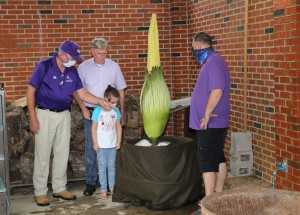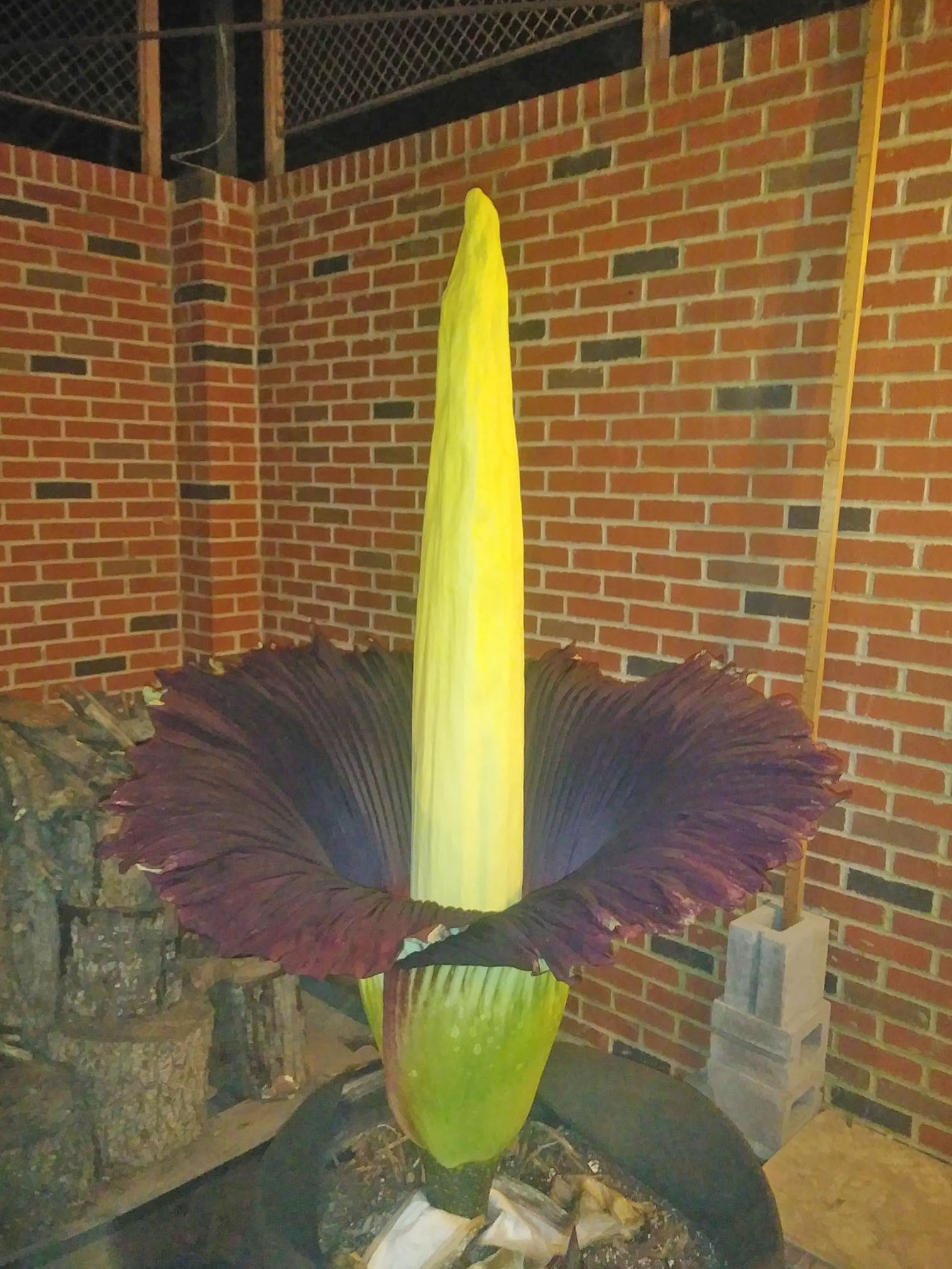NATCHITOCHES – After years of anticipation and several days of heightened expectation, Mr. Stinky, Northwestern State University’s resident corpse flower, bloomed in odiferous glory Friday night, fuming the Creative and Performing Arts Complex with the stench of a rank dumpster.
Mr. Stinky is an amorphophallus titanium or titan arum, a giant tropical plant native to Sumatra, Indonesia, that only flowers every seven or eight years. Believed to be the largest flower in the world, Mr. Stinky unfurled its deep purple bloom Friday night, drawing a crowd of plant enthusiasts and curiosity-seekers along with insect pollinators naturally attracted to the smell of rotting flesh.
Abetted by the moist, humid Louisiana night air, Mr. Stinky did not disappoint.
“This is just the coolest thing ever,” said Martha Dowden of Natchitoches who came to photograph the strange and beautiful plant.
The bloom began about 3:30 p.m. Friday when Stinky’s ruffled spathe began to loosen and flies began to buzz through the sculpture yard where the plant has been in residence since developing the spike that indicated a bloom was near. Mr. Stinky’s primary caregivers, Professors Millard Mangrum, Corbin Covher and John Byrd, awaited like expectant parents. Mangrum answered questions and offered background information on the plant to visitors and said his phone had been ringing off the hook.
An impromptu bloom party gathered Friday evening as the plant gradually opened and its potency became stronger. Colleague Michael Scanlan, who produces videos for NSU’s School of Biological and Physical Sciences, shared a live stream on social media platforms that picked up a combined 30,000 views.
Covher stayed through the night with the bloom, which reached maturity about 1:30 a.m.
“I was doing a few drawings of him. It stunk well outside the sculpture lab,” Covher said.
Mangrum acquired Mr. Stinky as a golf ball-sized corm in 2012 and nurtured it in the Bienvenu Hall greenhouse until it outgrew the space. Titan arum generally requires seven to 10 years of vegetative growth before blooming for the first time. After its initial blooming, some plants may not bloom again for another seven to 10 years while others may bloom every two or three years.
Since 2018, Mr. Stinky has lived outside Covher’s office in the NSU sculpture lab, a high-ceilinged climate-controlled workshop that could accommodate its leafy 10-foot tall canopy while the plant stored up food reserves for the corm. Corpse plants thrive in moist humid climates and can’t tolerate temperatures below about 55 degrees. The plant died down to the corm last fall and several days ago, a large spike emerged from the corm, growing 6-10 inches per day. The professors knew a bloom was imminent and wheeled Stinky outdoors into a damp, shaded corner of the sculpture yard, inviting other plant enthusiasts to view its pre-bloom state.
The bloom of a corpse flower is an exciting event for plant enthusiasts, and over the last week, Mr. Stinky has become something of a celebrity in the Natchitoches community as curious plant-lovers stopped by for a glimpse of the towering spike. Covher’s wife Natalie designed and distributed “I Smelled Mr. Stinky” stickers for those who viewed plant in bloom.
By mid-morning Saturday, Stinky’s bloom and fragrance were already fading. Mangrum said the bloom will fall away and a seed stalk will appear before that, too, dies away and the plant begins a new leaf cycle.
Scanlan began filming the plant several days ago and plans to share a time-lapse video of the bloom on the School’s Facebook page and youtube channel.
Mangrum estimated that over 400 visitors had been in and out of the sculpture lab to view the rare bloom and were still streaming in.
“It’s been amazing. There have been people who stopped by that said this was on their bucket list,” he said.
In addition to the large bloom spike, Stinky also produced a smaller spike that Mangrum speculated may or may not produce another bloom.
“We’re in high hopes that the second sprout makes a bloom,” Mangrum said. “There may be another bloom on the way.”

Mr. Stinky’s caregivers, Professors John Byrd, Millard Mangrum and Corbin Covher, shared information about the corpse plant with a young visitor just prior to the plant’s bloom.

